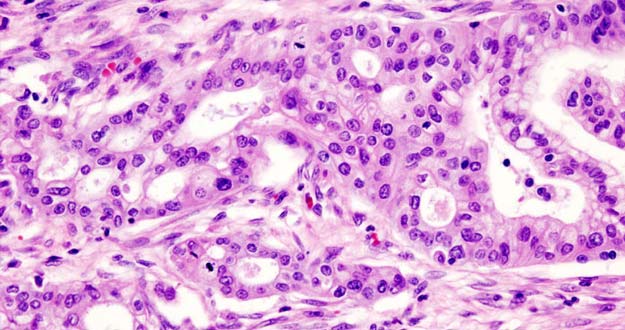Researchers at the National Cancer Research Centre (CNIO) have been discovered and characterized a novel specific marker of cancer stem cells: riboflavin or vitamin B2, a pigment that emits green fluorescence, as a result of their accumulation in intracellular vesicles.
This bright property is used for tracing, isolation and subsequent purification, without the need to use antibodies or other more complex techniques and higher cost.
The results of the research, led by the scientists: Irene Miranda, Bruno Sainz and Christopher Heeschen, published at the end of the last September-2014, in the journal Nature Methods.

Image of a pancreatic adenocarcinoma
"The discovery of this new marker is a breakthrough, because it identifies cancer stem cells are more invasive and chemoresistant. The autofluorescence, of these cells, allow tracking them in an easy, simple and cheap way, and to study the origin of the tumor chemoresistance", says Irene Miranda, first author of the article.
"Normally, we only see the tree leaves, representing tumors and we can not make out the roots, which are the true responsible for its progression and growth", illustrates Miranda.
Tumors are mosaics of morphologically and molecularly very different cells. In this cellular heterogeneity, it is estimated that 1-2% of the entire tumor mass is made up of tumor stem cells, identified, in recent years, as the responsible for the origin of cancer and resistance to conventional chemotherapies.
This very small percentage hinders their isolation and analysis, just like the study of the origin of drug resistance.
However, researchers have discovered that tumor stem cells accumulate vitamin B2, due to increased the ABCG2 protein, responsible for the transport of vitamin, into intracellular vesicles, that confer brightness to cells. The reason for this phenomenon is yet to be determined.
The discovery was made in several tumor types, including samples from patients of pancreatic cancer, liver, colon and lung.
Despite the unknowns about its nature, autofluorescence could pursue personalized medicine of the future and the development of more effective cancer treatments.
"From now on, we can isolate the autofluorescent cells, from a biopsy, and test their sensitivity, in a panel of experimental drugs or already on the market", say Sainz and Heeschen.
"So, we want to accelerate the identification of new drugs or combinations thereof, that are able to kill cancer stem cells, for that particular patient", says Sainz.
The study was funded by the European Union, the Carlos III Institute of Health, the Ministry of Economy and Finance of the Government of Spain and the Foundation 'La Caixa'.
Well, I am glad seeing that researchers are working hard to find a definitive solution to all types of cancer. I hope to see it someday.
Until my next post, kind regards,
Luis.
Sponsored by Costaluz Lawyers.
Please click below:
